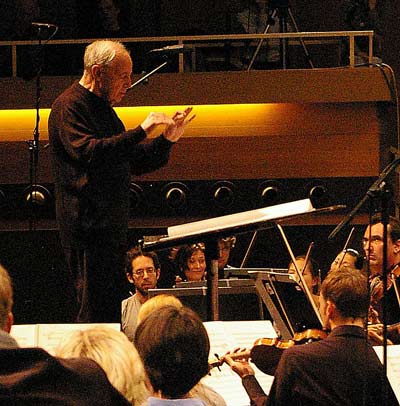Boulez, Pierre (1925–2016)

Pierre Boulez conducting, as usual without a baton, in 2008.
Messiaen's most talented pupil was Pierre Boulez, who studied with him at the Paris Conservatoire after moving to Paris in 1942 from his native Montbrison in the Loire region. Boulez was originally destined for a career in engineering, but instead applied his exceptional mathematical brain to musical analysis and composition.
Twelve-tone music, which Boulez studied in the late 1940s with Schoenberg's pupil Rend Leibowitz (1913–1972), influenced his own early works, the Sonatina for flute and piano (1946), the First Piano Sonata (1946), and Le visage nuptial (The Nuptial Countenance, 1946–1947) for chamber ensemble, including two ondes Martenot. In 1948 his talent was recognized with the Beethovenian Second Piano Sonata and the cantata Le soleil des eaux (The Sun of the Waters), based on poems by René Char. The same year he began working on the "multiple choice" collection Livre pour quotuor for string quartet, to which he attempted to apply a technique of "total serialization". His most successful essay in this genre was Structures I (1952) for two pianos, but he quickly realized its limitations, and during the 1950s abandoned it in favor of freer techniques. He came to international attention in 1954 with Le marteau sans maître (The Hammer without a Master), settings of René Char poems for contralto and ensemble.
During the late 1950s and '60s Boulez taught at Darmstadt (an important center of new music), Basle and Harvard. He also established a parallel career as a conductor. He was musical director of the BBC Symphony Orchestra (1971–1975) and also of the New York Philharmonic (1978), and was a sought-after guest conductor (he conducted Wagner's Ring cycle at Bayreuth in 1976, and the first production of Berg's Lulu in Paris). From 1977–1992 he was the founder-director of the Institut de Recherche et de Coordination Acoustique/Musique (IRCAM) in Paris, which provides computers and digital facilities for composition.
His most important later compositions – many of which are still being revised - include the Third Piano Sonata (1957), Pli selon pli (Fold upon fold) for orchestra, Eclat/Multiples for ensemble, Rituel in memoriam Bruno Maderna (1974–1975), two works called Dérive for small ensemble, Domaines, for clarinet and 22 instruments (1961–1968); ...explosante-fixe... (1971–1989), and Répons, for ensemble including computers and live electronics.


